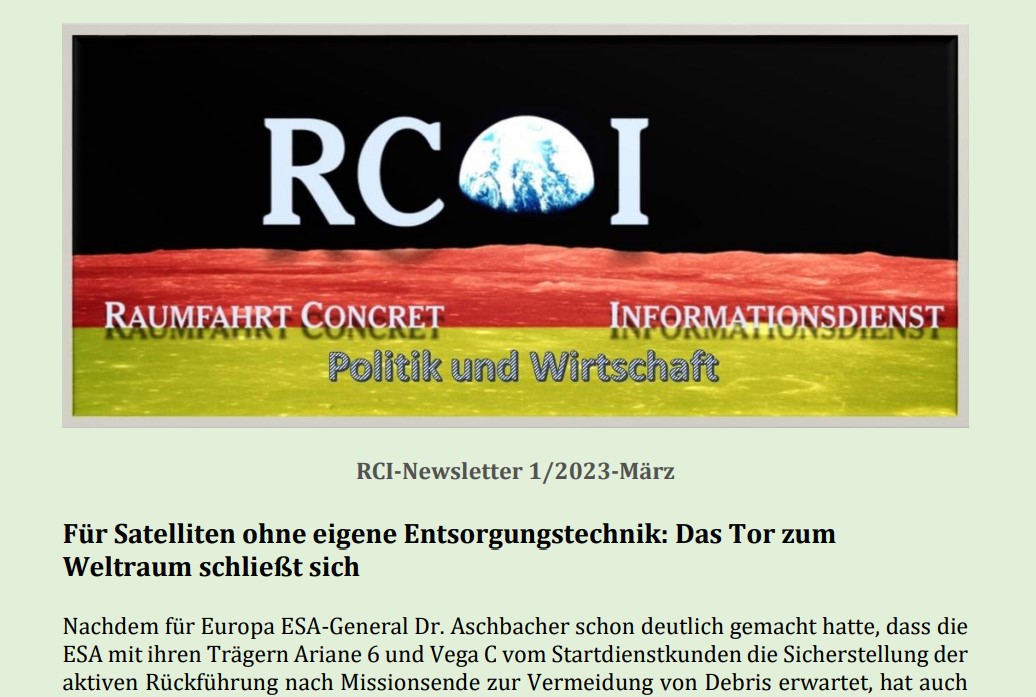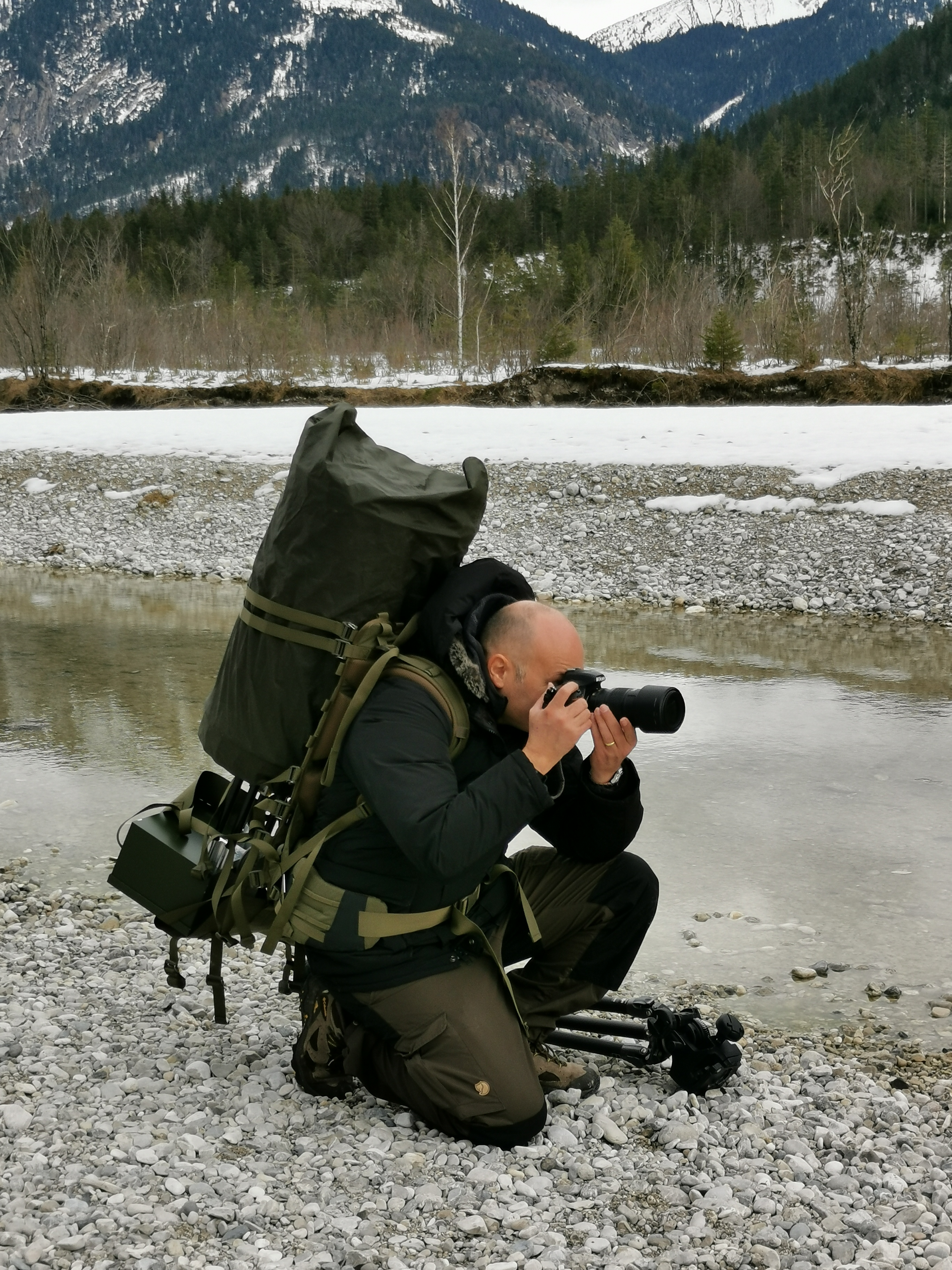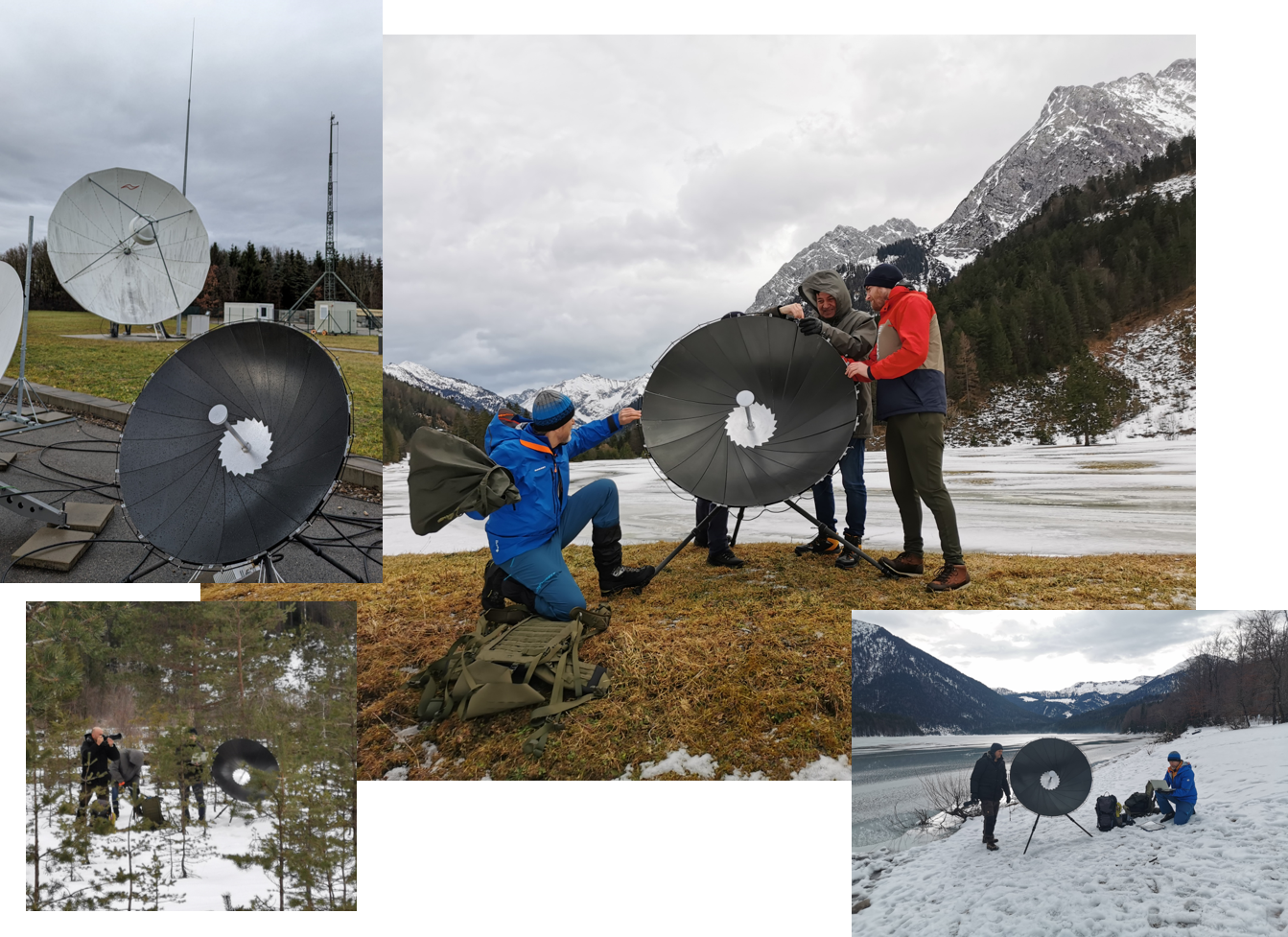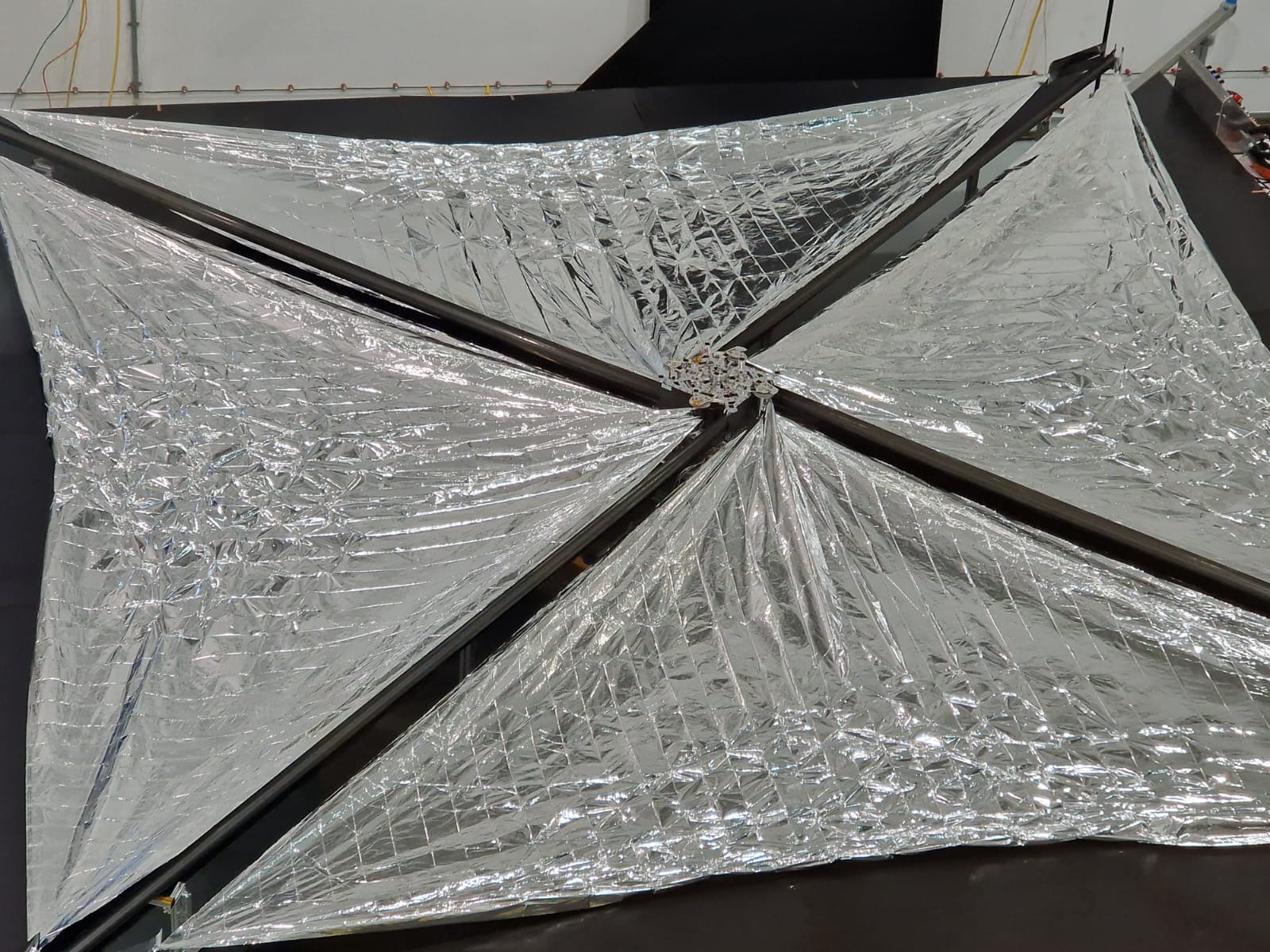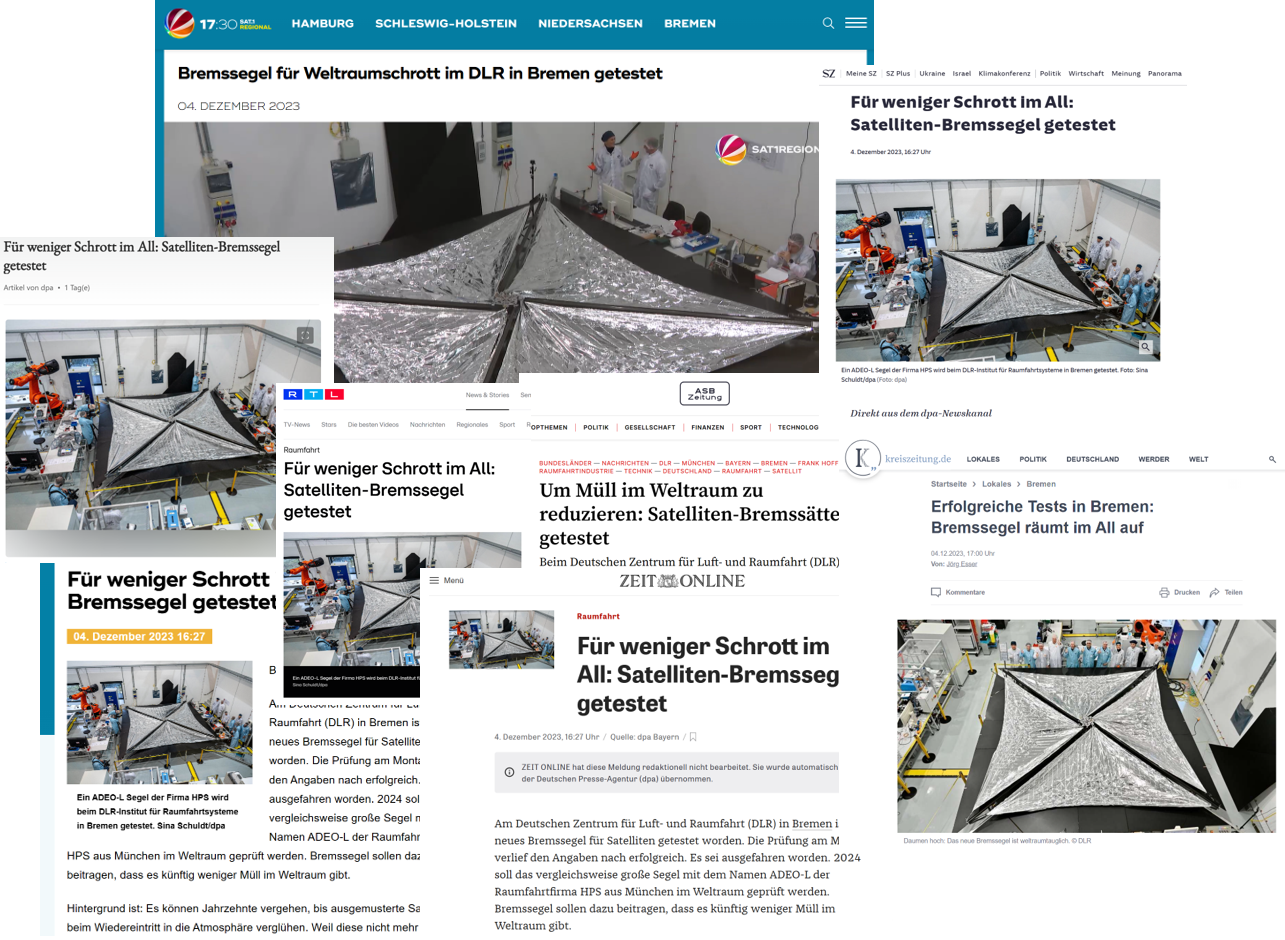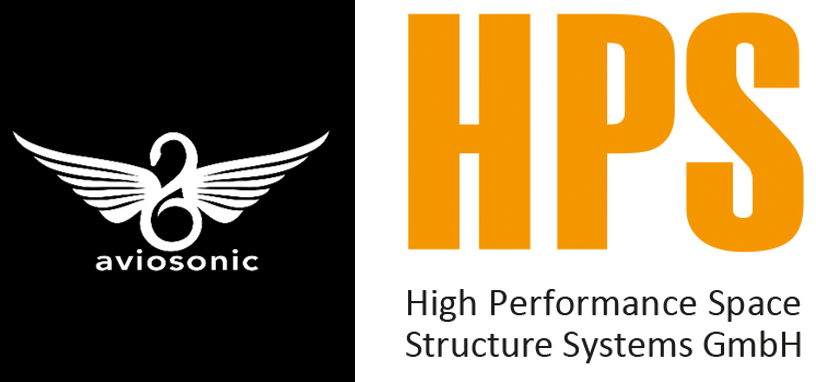January 2024
HPS Space News
KEAN II passes the acid test at the University of the German Armed Forces and in the field
KEAN, the integrated deployable lightweight manpack complete antenna from HPS and its development partners, has taken a decisive step forward in the KEAN II (Second Generation) version: it passed the tough link test at the University of the German Armed Forces in Munich in December 2023 and the handling test in the field. This brings the goal of the joint HPS project much closer: the development of a complete system for bidirectional satellite communication based on preliminary developments already carried out by HPS and these specifications:
- Conformance to satellite operators (e.g. EUTELSAT, INTELSAT)
- Ku-band, 1.2 m diameter, also X- and Ka-band capable
- Including communication system, electronics, battery, tripod, backpack carrying system
- Total weight <20 kg
- Commissioning in under 15 minutes from backpack transport to satellite link
- Innovative, cybernetic folding mechanism based on the opening and closing of flowers
- Design and definition of components and production processes suitable for series production for a rapid transition to series production in large quantities.
Partners in the project are:
- The system supplier MTEX (Wiesbaden) with a focus on ground stations and electronics.
- The start-up Blackwave (Ottobrunn) with the economical series production of complex carbon components.
- The Chair of Carbon Composites (LCC) at the Technical University of Munich for the design of innovative extremely lightweight reflector fins.
- The Bundeswehr University for defining the user requirements and carrying out the antenna link tests with satellites.
The additional antenna deployment tests in rough terrain in the Bavarian Alps were closely monitored from the air by camera-guided drones; they provided complete documentation of the challenges, but also of the success of these tests. Videos are available at the YouTube Channel. Particular attention was paid to features and elements such as these during the tests:
- Wearing comfort off-road (walking and running) with different body sizes
- Assembly and disassembly over time in rough terrain (bushes, gravel, snow)
- Speed of unfolding and folding
- Handling by untrained test persons
- Wind load compatibility
- Handling in cold conditions (requirement: from -30o C to +55 o C)
- Robust construction
The target markets for applications of this completely new technology for communication via satellite, especially on X-, Ku- and Ka-band, cover all three conceivable directions:
- commercial, such as journalistic reporting from rough terrain
- institutional, such as rescue and disaster relief operations
- military, such as for small special forces operating independently of vehicles without a direct connection to the base of fully equipped large units
- scalable up to 3.6 m, also for mobile transportation on small vehicles.
Beyond the technical successes, KEAN II is currently growing wings from a completely different direction: the European Commission’s major IRIS2 project to establish absolutely secure connectivity via a dedicated multi-orbit constellation of several hundred satellites from LEO to GEO is giving a significant boost to all those application scenarios that were previously considered to have only seen very hesitant development due to their dependence on non-European constellations and individual satellites. This applies in particular to the institutional and military markets, both of which are now growing into larger dimensions.
The last stage of development was funded by the German Aerospace Center (DLR) as part of the ILKA project with funds from the Federal Ministry of Economics and Climate on the basis of a decision taken by the German Bundestag.
The magic triangle: competence – quality – capacity
January 2024
Servicing Europe´s ambitions in space from Romania
In less than a blink of an eye, it will be a full decade that Romania´s leading space-SME “High Performance Structures Inovatie si Desvoltare S.R.L.” will look back to the beginnings of the company´s history in 2016, when it opened its office in Bucharest. Founded to meet the needs for additional capacities of HPS Munich, HPS RO quickly developed ttowards becoming one of the most renowned full-service spacetech-companies from ESA-member states in the Eastern Europe.
Just one question to managing director Astrid Draguleanu:
From the very beginnings and through the years, you have been in the position to significantly participate in shaping and guiding the company´s development. From your perspective, which factors are the ones that keep pushing HPS forward on the road of success?
From our point of view, there are three rock solid pillars the company´s success rests on.
Number one: COMPETENCE. HPS RO is an engineering company, with driven top engineers trained in the sectors of engineering, development, assembly, secondary and tertiary structures, thermal and RF-components, mechanical ground support equipments. In addition, we have managed to combine forces with commercial and institutional suppliers and partners, contributing competencies in special segments like precision manufacturing, welding, process verification, and assembly tests. So when one´s looking for a onestop source of competence in Romania and ESA´s Eastern European presence as a whole, they will sure find it in Bucharest.
Number two: QUALITY. In the Space Industry, quality is attributed to those who manage to comply to the specific standards and building up an immaculate heritage of successful steps on the ladder to the top. HPS RO proved that it has taken those steps, and done it with at an amazing pace: In the past eight years we have contributed to a total of twelve Space Missions so far. To get an idea of what´s behind that, let us just take a more detailed look at the contributions we´ve made in the area of mechanical ground handling and support equipment, MGSE:
- Purge Equipment for the JUICE Spacecraft on behalf of Airbus Germany
- Satellite Vertical Integration Stand for the Biomass-Mission, Airbus U.K.
- Instrument & Optical Bench Lfting Frames, Copernicus Chime Mission, OHB
- Instrument Turntable Support Stand and Instrument Turntable, Instrument Alignment Trolley, Instrument Lifting Device, Multipurpose Adapter, Vibration Test Adapter, Vertical Integration Stand, Instrument Support Structure and Instrument Mass Dummy for the METOP mission, Airbus Germany
- Satellite Hoisting Device, transport containers, various adaptors – in total 14 MGSE-assemblies for Copernicus CIMR by HPS Germany.
Number three: CAPACITY. From the very beginning, it has been absolutely clear to all of us that HPS RO has a great future, by focusing on its character as a company with high professional level and not afraid of hard work. That is why building and keeping up capacities is yet another pillar we use. Take, for example, the fact that, before having even one contract to justify the expenditures, we started out from the beginning with production facilities, giving room the even the most ambitious dreams of development. And it proved to be the golden path to go: Apart from servicing all current needs of customers, we were most happy to have the capacities for starting out the series production of the HPS Satellite Dragsail product family “ADEO”, when the winds of change reached politics and deorbit technology became a legal prerequisite to let a satellite go into space to begin with. Of course, we apply this philosophy of “growth follows capacity” also to our HR-management. Today we employ a total of 20 engineers in Bucharest, growing in numbers at top speed. We are convinced that the reason for the whole success story is the delicate balance we have learned to keep in our magical triangle of COMPETENCE, QUALITY, and CAPACITY.”
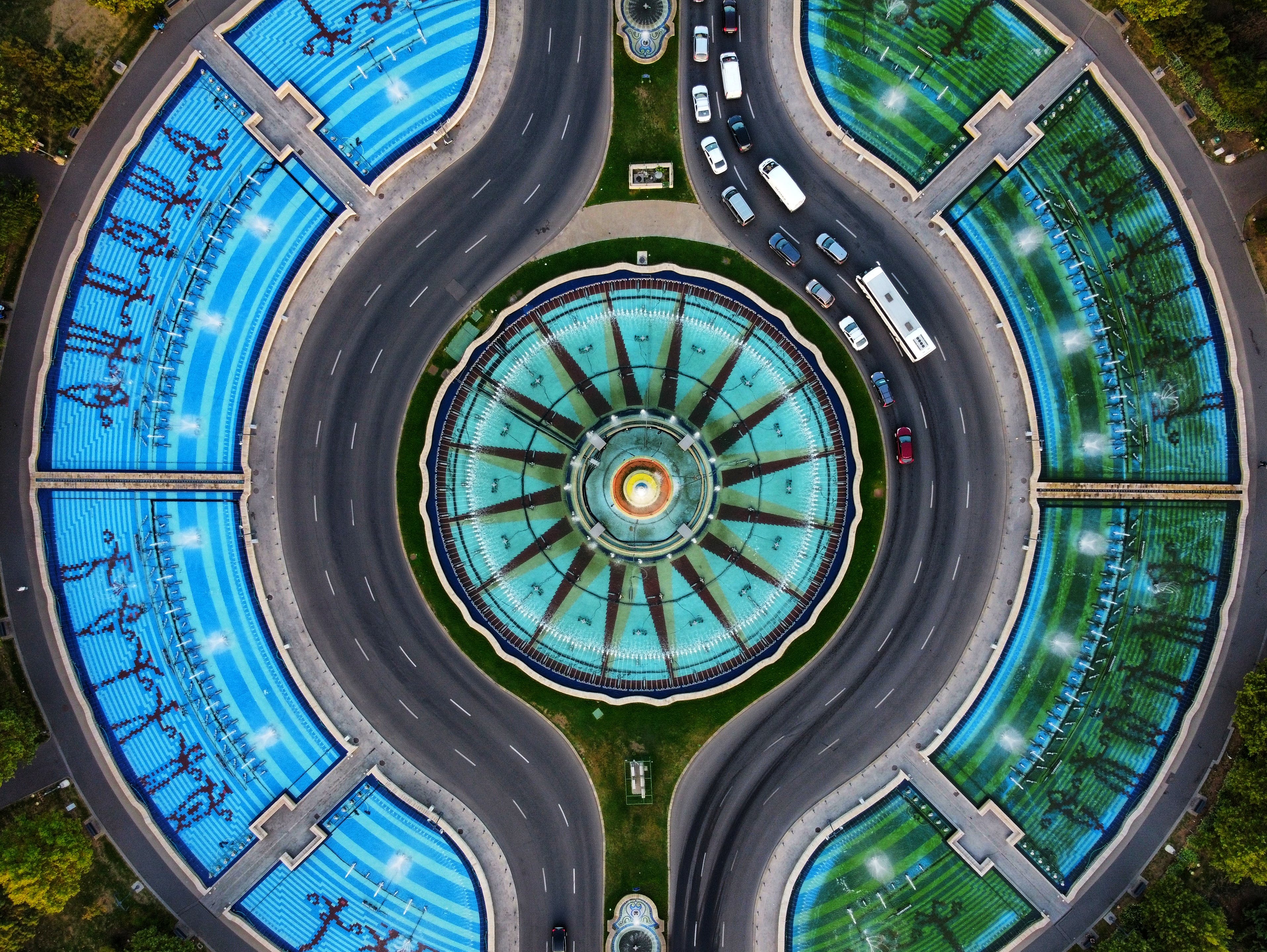
The Munich-based space-tech company HPS had this development in mind more than ten years ago, when no one else was really thinking about ways to avoid space debris. With great support from the space agencies ESA and DLR, the DLR institutes in Bremen and Braunschweig, the companies DSI, Bremen, and formerly HTS, Coswig, plus a seven-digit-investment of HPS, the company´s highly committed young team of experts has created an entire product family under the generic name ADEO, from the smallest versions ADEO-P (Pico), ADEO-C (Cube) and ADEO-N(Nano), ADEO-M (Medium) and the latest member of the group, ADEO-L (Large). The development master plan not only extends even further to possible ADEO variants with up to 100 square meters of braking surface, but also leaves enough room for derivatives with completely different applications, such as the monitoring of space debris smaller than1 cm directly in space.
In its largest flight-ready version to date, L1, ADEO has a take-off weight of 10 kg at dimensions of 43 cm x 43 cm x 25 cm; in contrast to the smaller versions, this unit also requires its own power supply for motor-controlled deployment of the masts and sails. ADEO-L1 generally fits perfectly on satellites up to the 1,500 kilo class.
In the first quarter of next year, ADEO-L1 will be integrated onto a satellite of the Belgian company Redwire for its first test flight at the end of 2024/beginning of 2025 as part of a EU program, while the versions ADEO-N1 and ADEO-N2 have already passed their baptism of fire in space. Approaching the fiery finale is currently ADEO-N2, deployed in December 2022. Since then, it has already lowered its satellite from an orbital altitude of 510 km to 460 kilometers in only 12 months without the aid of any fuel or attitude control. Expected “arrival” in a completely burnt-up state: mid2025 – and thus even around five times faster than without sails and twice as fast as prescribed.
ADEO-L1 will master this path of final in-orbit verification just as safely, company boss Dr.-Ing. Ernst K. Pfeiffer is certain. As with the other versions, it will then go straight into series production for which the company has special production facilities at its Munich and Bucharest sites.
ADEO L1 “ready for lift-off”: World’s largest operational brake sail for the disposal of space debris successfully tested
Dezember 2023
ADEO L1 “ready for lift-off”: World’s largest operational brake sail for the disposal of space debris successfully tested
HPS completes the ADEO sail fleet with its first largest version under the version named L1. Its 25 square meters of sail area unfolded successfully deployed on Monday, 4th of December 2023 in a final ground test after a complete completed PFM qualification campaign. This included vibration tests in all axes as well as tests under thermal vacuum, including hot and cold firing tests (tests to verify the deployment release mechanisms under extreme temperatures). The tests were carried out under responsibility of HPS Munich at the facilities of the DLR Institute of Space Systems in Bremen – a prime example of cooperation between industry and research & development. This final and most important test enjoyed great interest from the media (including SAT1, RTL, NTV, DPA) covering the 20-minute deflation process and interviewing the enthusiastic project team of HPS and DLR. Links to the articles and television videos can be found HERE.
This test is also a success of ESA’s GSTP program, which significantly supported the development of ADEO-L1 financially and technically. Technology programs in general are essential for independent SMEs in the space industry and their products on the way to market readiness and worldwide series sales.
The ADEO brake sails deploy after the end of the satellite’s mission and brace themselves against the resistance of the atmosphere that still prevails in orbits up to an altitude of just under one thousand kilometers. This deployment immediately leads to a drastic reduction of the speed of the satellite and the entire package sets off on its accelerated descent towards the earth’s atmosphere, where it then burns up in the frictional heat of up to two thousand degrees Celsius. The entire return process takes even significantly less time than the latest guidelines prescribe. Until recently, the process could take up to twenty-five years, while it must now be completed within five years. And, to ensure that operators follow the rules, launch service providers such as SpaceX no longer even take satellites into space if they are not equipped with the appropriate return technology from the outset.
The Munich-based space-tech company HPS had this development in mind more than ten years ago, when no one else was really thinking about ways to avoid space debris. With great support from the space agencies ESA and DLR, the DLR institutes in Bremen and Braunschweig, the companies DSI, Bremen, and formerly HTS, Coswig, plus a seven-digit-investment of HPS, the company´s highly committed young team of experts has created an entire product family under the generic name ADEO, from the smallest versions ADEO-P (Pico), ADEO-C (Cube) and ADEO-N(Nano), ADEO-M (Medium) and the latest member of the group, ADEO-L (Large). The development master plan not only extends even further to possible ADEO variants with up to 100 square meters of braking surface, but also leaves enough room for derivatives with completely different applications, such as the monitoring of space debris smaller than1 cm directly in space.
In its largest flight-ready version to date, L1, ADEO has a take-off weight of 10 kg at dimensions of 43 cm x 43 cm x 25 cm; in contrast to the smaller versions, this unit also requires its own power supply for motor-controlled deployment of the masts and sails. ADEO-L1 generally fits perfectly on satellites up to the 1,500 kilo class.
In the first quarter of next year, ADEO-L1 will be integrated onto a satellite of the Belgian company Redwire for its first test flight at the end of 2024/beginning of 2025 as part of a EU program, while the versions ADEO-N1 and ADEO-N2 have already passed their baptism of fire in space. Approaching the fiery finale is currently ADEO-N2, deployed in December 2022. Since then, it has already lowered its satellite from an orbital altitude of 510 km to 460 kilometers in only 12 months without the aid of any fuel or attitude control. Expected “arrival” in a completely burnt-up state: mid2025 – and thus even around five times faster than without sails and twice as fast as prescribed.
ADEO-L1 will master this path of final in-orbit verification just as safely, company boss Dr.-Ing. Ernst K. Pfeiffer is certain. As with the other versions, it will then go straight into series production for which the company has special production facilities at its Munich and Bucharest sites.
HPS wins German government space competition with ADEO deorbit sail
November 2023
Space sails from the ADEO series enable legal launch and disposal of satellites
As part of the National Program for Space and Innovation and based on the decision of the Budget Committee in November 2022, the German Space Agency launched a competition for promising space innovations. The winner can expect a fully organized and financed demonstration flight with launch by 31.12.2025. On Thursday, 23 November 2023, the Federal Government’s Space Coordinator, Dr Anna Christmann, selected Munich-based space technology company HPS as the winner of the competition in the small satellite payload category with its ADEO-Cube space sail version at the 2023 Small Satellite Conference. The ADEO product family is designed as a series with different model types (Pico, Cube, Nano, Medium, Large), with which all satellites from the Cubesats to the larger representatives with 1.5 tons (class “M”) are automatically removed from low Earth orbit (LEO) and disposed of at the end of the mission. This so-called “deorbiting” with the ADEO braking sail not only fulfills, but even undercuts the maximum duration of 5 years that will apply from October 2024 instead of the 25-year guideline that has been in place since the 1960s. Quite simply, this means that no satellite will soon be accepted for launch without special on-board technology, such as the appropriate space sail from HPS’s ADEO series, if it cannot otherwise be legally disposed of. Since SpaceX, for example, as the leading launch service provider, will be introducing this rule from October 2024, it will apply to practically all future satellites, including those that are already in the design and manufacturing phase today.
As HPS CEO Ernst K.Pfeiffer, there is still only one alternative to ADEO, but it “is chemical, expensive and – in the case of a damaged satellite – inoperable”, the passionate aerospace engineer states about the market position of the ADEO space sail: “ADEO is currently the cheapest, most reliable and cleanest solution for legal deorbiting on the global market, available in all classes thanks to series production at HPS Bucharest and HPS Munich, and highly competitive in the hotly contested commercial market for satellite technology.We at HPS, especially our development team, are all very pleased that our sustainable technology has been recognized by the Small Satellite Competition at the highest level.”
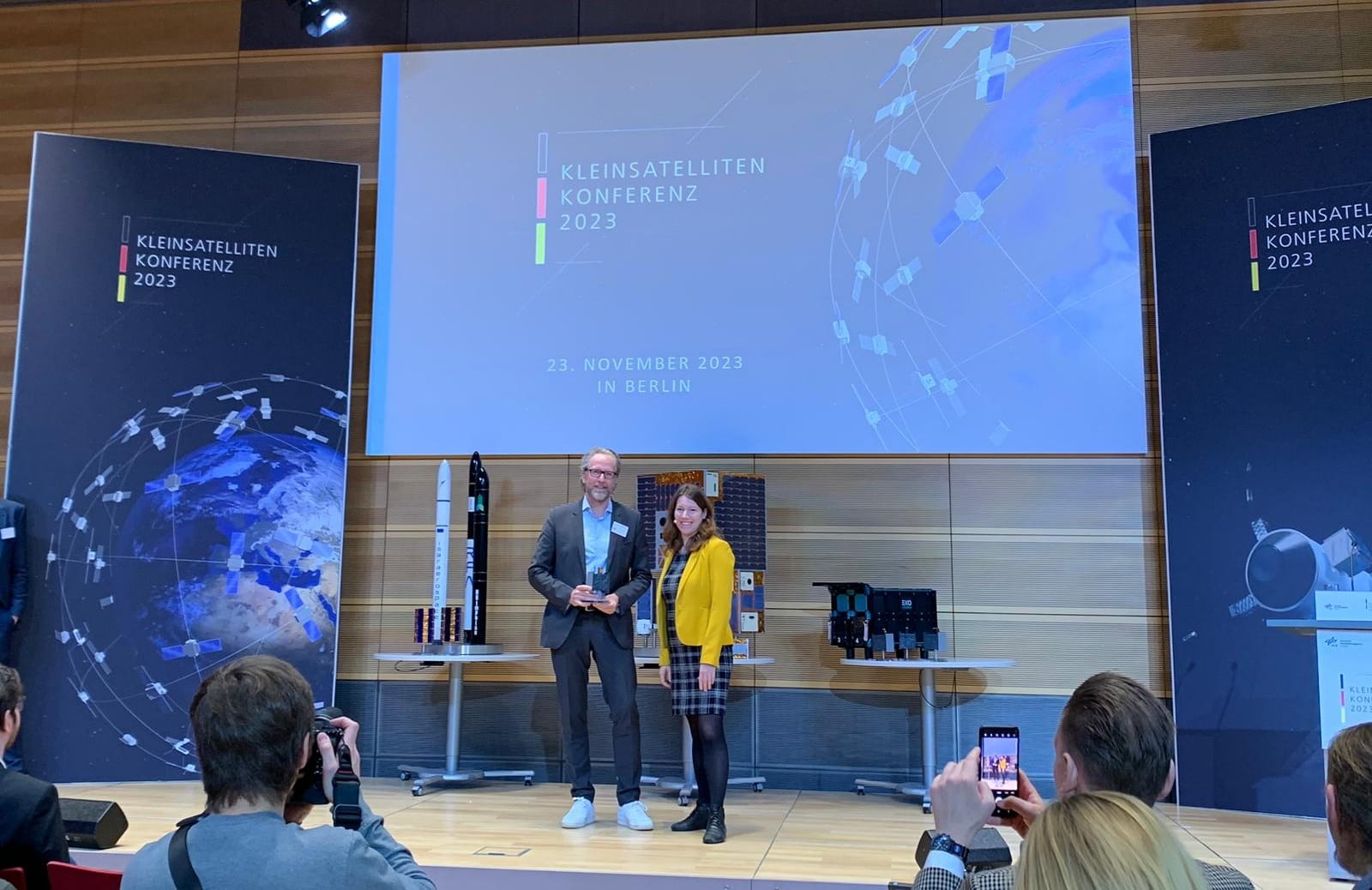
Three months from Kick-off until the breadboard of the feed is tested
July 2023
Three months from Kick-off until the breadboard of the feed is tested
The picture shows our breadboard model of the feed developed by HPS for the BANT antenna during the RF test done at MVG Italy using the StarLab measurement system. The purpose of the test is to validate the feed design by comparing the RF simulations with the results of the measurement.
Adopting the New Space approach, it took only three months from the project Kick-off until the breadboard of the feed is tested. The flight model of the BANT antenna, where this feed will be installed, will be ready to be integrated on the spacecraft at the end of this year, the satellite will be then placed in Low Earth Orbit for a remote sensing mission.
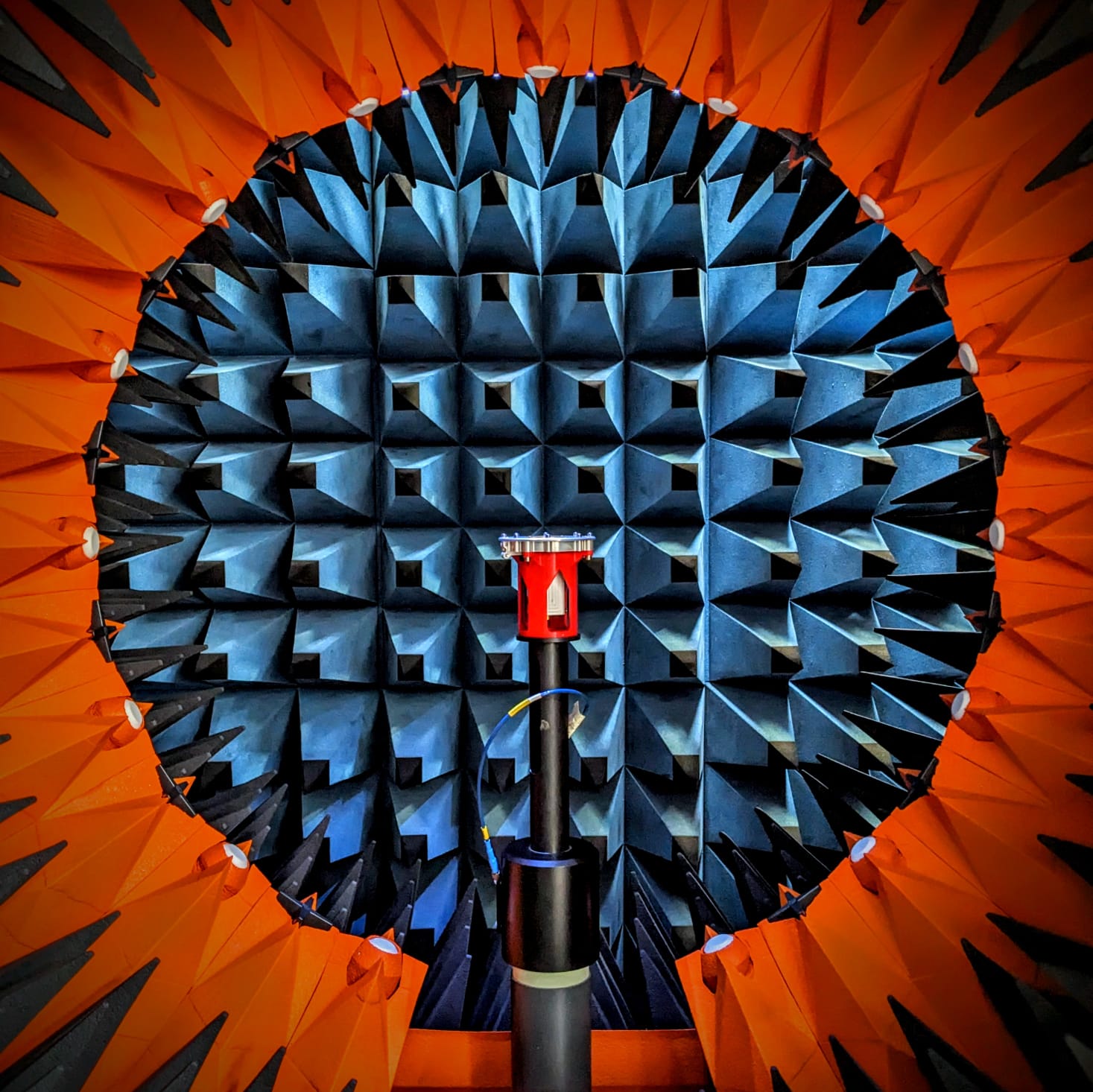
HPS congratulates ESA and TAS to the launch of EUCLID and to the successful checkout of the downlink antennan chain!
July 2023
State-of-the-art antenna to serve one of the most ambitious science missions ever
HPS, leading provider of advanced antenna- and reflector-technologies, applauds the ESA – European Space Agency and to the mission prime ThalesAleniaSpace (Italy) to the launch of space mission EUCLID (within European Space Agency’s Cosmic Vision Programme) on Saturday, 01.07.2023, which aims to unravel the mysteries of the dark universe and gain insights into the nature of „dark matter“ and „dark energy“. On Sunday, 09.07.2023 it has been confirmed that the „K-band signal has been received from EUCLID“ by the ground station on Earth.
Euclid is now the biggest transmitter of data (in terms of data rate of about 74 Mbps) from trans-lunar space: Read here the article from ESA
EUCLID´s “Antenna Reflector Assembly (ARA)” developed by HPS, together with its subcontractor Invent represents a significant advancement in space communication technology. Its innovative design and advanced features make it an ideal choice for the mission, enabling high-speed data transmission and reception from the spacecraft to Earth and back, bridging the distance of 1,5 Mio km. A deep “Thank You” for the trust into our team to our Customer Chain TAS (SP) – TAS (IT) – ESA, backed by our German Space Agency DLR.
Key features of the HPS ARA:
- Enhanced Signal Reception: The CFRP-based reflector’s high-gain capabilities, also under high temperature grades far away in L2-orbit, ensure optimal reception of the weak signals from the EUCLID spacecraft, enabling precise data collection on Earth from distant corners of the universe.
- High-Speed Data Transmission: Equipped with the reflector‘s state-of-the-art transmission CFRP material technology, the HPS-antenna facilitates rapid data transfer in K-band, allowing for real-time analysis and quick response to mission requirements.
- Robustness and Reliability: Designed to withstand the harsh conditions during launch and in space, the reflector assembly is built with durable materials.
- Compact and Lightweight: HPS` antenna design prioritizes accommodation efficiency without compromising its performance. Its compact size and lightweight construction optimize interface loads to the spacecraft and payload capacity.
“We are thrilled to contribute significantly to the EUCLID mission with our advanced reflector assembly,” says Ernst K. Pfeiffer, CEO of HPS. “Our cutting-edge CFRP-technology, developed for more than 15 years, can now play a crucial role in facilitating seamless communication between the spacecraft and ground stations, allowing the investigation of dark material by huge amount of data downloaded to Earth.”
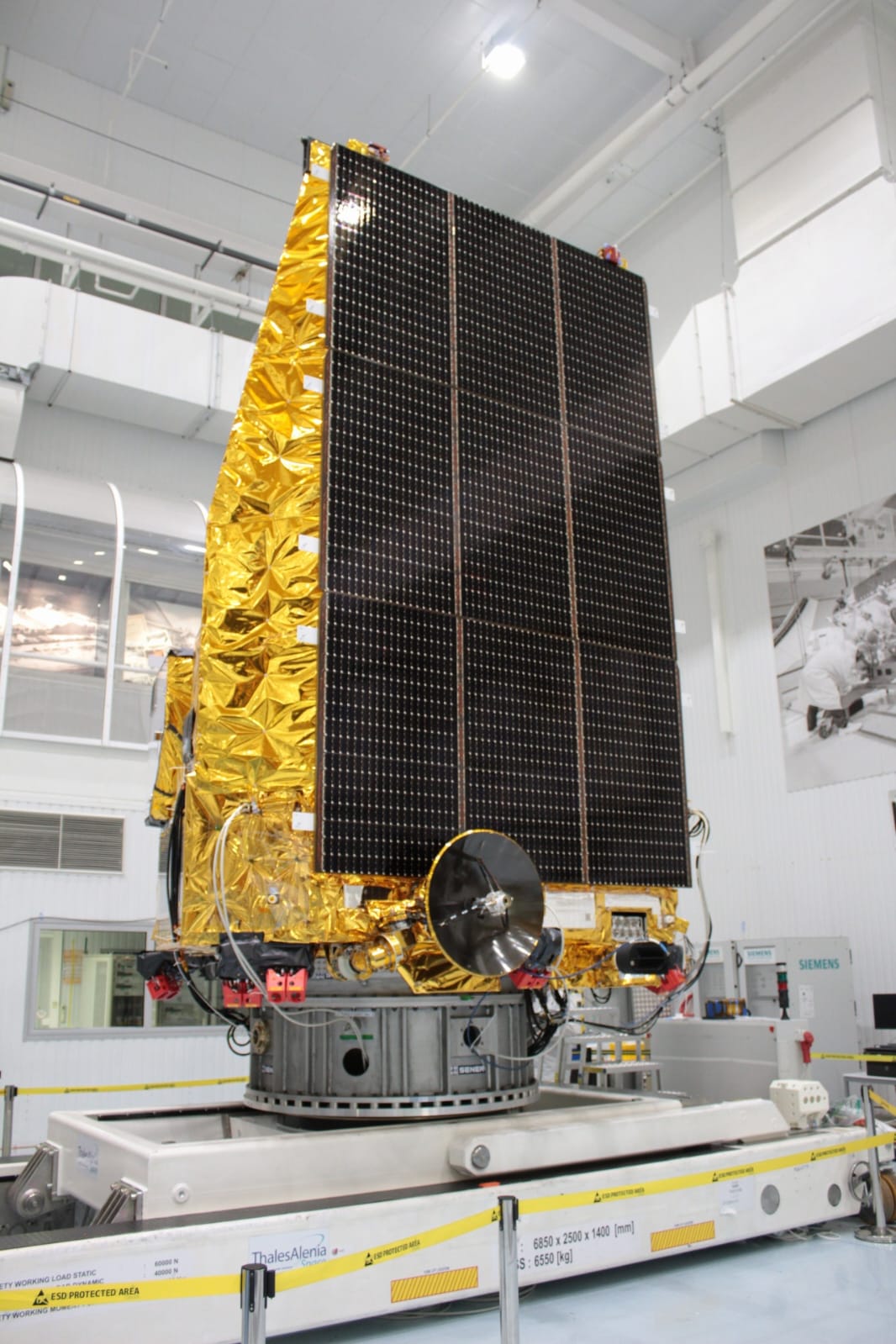
Picture by ESA
For the Sake of Safety and Sustainability in Space: OKAPI:Orbits´ AI now available as Assistance System to ADEO Deorbit Sail for Satellites
June 2023
Germany´s leading collision avoidance system reliably predicts the perfect slot for descent through tons of debris and space traffic.
When, after two, five or more years of operation, a satellite is supposed to leave its orbit and re-enter Earth, it’s a ride on the skyway to hell in two respects: first, for the satellite which is destined to burn up in the atmosphere, but also for other satellites as well as for an encounter with scrap parts that could hit it like unguided missiles – and produce even more junk. Satellites equipped with the ADEO braking sail from HPS are already in automatic descent mode. From now on, however, this can be upgraded by the Collision Avoidance system from industry-leading German startup OKAPI:Orbits. The company emerged as a spinoff from Braunschweig University of Technology in 2018 after over 40 years of intensive research. This Collision Avoidance System minimizes the collision risk during the de-orbit trajectory by figuring out the situation even ten days in advance. Appropriate maneuvers are also recommended for the satellite’s control system. This is made possible by the unique AI behind OKAPI:Orbits.
“Picture a distant view of 6.72 million kilometers of orbits on which about 10,000 satellites, 1,000,000 large and medium objects and 130,000,000 small ones exist that are not currently trackable. This is how complex computing operations is. Now, we should also take into account their velocity of 20,000 to 30,000 kilometers per hour. To any human sensibility, this is pure chaos, which the artificial intelligence behind our Collision Avoidance Software handles with aplomb,” says OKAPI’s company CEO Kristina Nikolaus.
Ernst K. Pfeiffer, CEO of HPS, a medium-sized innovation company, adds, “Our ADEO braking system not only performs the fastest possible passive descent even under adverse conditions – for example, when the satellite is already dead – it is also the deorbit solution with the largest safety reserve directly on board. Customers who don’t want to rely solely on their own software to control their satellites will find a unique safety architecture for the deorbit of almost all satellites with ADEO’s optional assistance systems for position tracking (Aviosonic) and optimal descent prediction (OKAPI:Orbits) at HPS.” ADEO is under discussion as a deorbit subsystem for the satellites of Europe’s coming constellation IRIS2 and “together with the features of Aviosonic and OKAPI:Orbits it levers the constellation to the most secure and sustainable one also after satellites’ nominal lifetime.”
During descent, the combination of all three technologies onboard the satellites will increase significantly the orbit determination and prediction, which is a unique advantage also for other satellites, constellations and stakeholders like owners, operators, and insurers.

HPS is Prepared to Provide ADEO Special Stealth Sail Edition for Europe´s IRIS2 Constellation Satellites
May 2023
HPS is Prepared to Provide ADEO Special Stealth Sail Edition for Europe´s IRIS² Constellation Satellites
The ever-growing number of satellites orbiting Earth presents a significant challenge in terms of space debris management. As space agencies and private companies deploy increasing numbers of satellites, finding effective and sustainable solutions for their safe disposal has become paramount. In this regard, the ADEO Deorbit Sail, developed by HPS offers a groundbreaking technology that enables controlled and efficient satellite deorbiting for mitigating space debris and ensuring long-term sustainability in space. By harnessing the natural forces present in space, such as solar radiation pressure and atmospheric drag, the sail facilitates controlled reentry of satellites into Earth’s atmosphere at the end of their operational life.
ADEO has already reached ESA´s hightest level of maturity, TRL 9 and proven its reliability on a number of spaceflights; getting ready to serve Europe´s new constellation IRIS2 its NewSpace-team at HPS, Munich, take it even one step further and introduce the ADEO special “stealth” sail edition. While irritating reflections and view blocking effects of conventional constellations like Starlink cause a permanent nuisance to other users of space like astronomers during flight and deorbit, the constructors of Europe´s constellation IRIS2 are going can count on to receive from HPS an exclusive offer for a special version: the ADEO Stealth Sail –invisible, fully transparent and also available for most satellite types and operational orbits.
As HPS-CEO Ernst K. Pfeiffer explains: “Our ADEO deorbit system already presents numerous benefits and applications in satellite end-of-life management like cost- & mass-effective and sustainable deorbiting, compliance with current and future Space Debris Mitigation Guidelines, flexibility and adaptability. Now, with the special stealth version for dedicated to the architects of Europe´s IRIS2 constellation we take the decisive step to let Europe set yet another standard in space sustainability”.
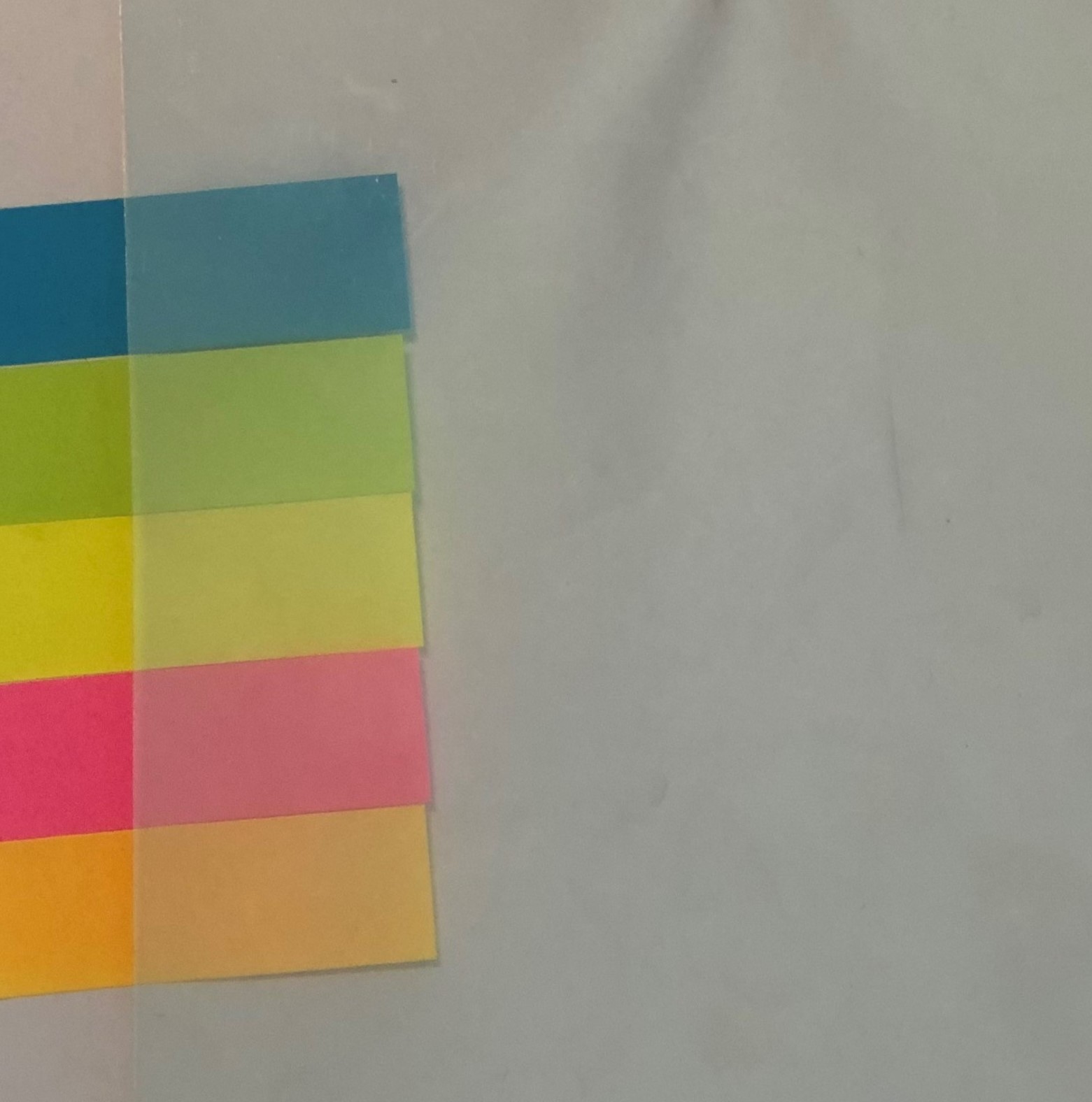
MoU of Space SMEs Aviosonic and HPS to join forces fighting space debris – right in time for Europe´s new constellation Iris2
Mai 2022
Aviosonic´s patented DeCAS for tracking and re-entry footprint prediction extending high-tech-lead of Europe´s satellite deorbit system “ADEO” unassailably
(Munich-Milano, May 10th, 2023). At testified TRL-9 and with solid flight heritage the sail system “ADEO” already is the leading device for quickly deorbiting almost all satellites, thus preventing spacecrafts after their end of mission from becoming as well as producing new space junk for years to come. Because it is a sail, it does not produce any pollution itself, chemical or otherwise, and because this very sail will be in its next version also transparent and absolutely non-reflective, it does not cause any irritations to any space observer on earth. Munich based spacetech innovator HPS, a medium sized company with a subsidiary in Romania and a total headcount of 80, has invested – together with several institutional and industrial partners – 12 years of constant development and qualifying into ADEO, and is now ready to take yet another giant leap by joining innovative forces with Aviosonic Space Tech, Milan/Italy.
Aviosonic Space Tech, born in 2015, owns the patented DeCAS system (Debris Collision Alert System) for in-orbit/de-orbit tracking and re-entry footprint prediction of space vehicles. DeCAS is a 1U mm system which always maintains a constant link with the ground operation center allowing precise information on the satellite position, aliong with the calculation of the re-entry footprint in real time, with the aim of collision avoidance between satellites, satellites and aircrafts as well as to alert government agencies. The technical characteristics and modularity allow DeCAS to be installed on any space vehicle, offering different services depending on the mission requirements. DeCAS, which took part in different space missions, provides a unique service for satellite tracking, decommissioning and re-entry prediction in real-time.
Prof. Piermarco Martegani, CEO of Aviosonic Space Tech says:”The integration between DeCAS and ADEO allows the creation of a unique product on the market capable of strongly implementing the safety of space operations both during orbital and decommissioning re-entry phses, even in the event of failure of the hosting satellite. This safety information is also needed by the Air Traffic Management System. The collaboration between Aviosonic Space Tech and HPS is the demonstration that in order to guarantee safety during space operations, an international cooperation between SMEs is necessary.”
HPS-CEO Ernst K. Pfeiffer shows bulletproof confidence in the future of ADEO on the world market and emphasizes: “ADEO has all the facts on its side: first, all space industry badly needs a deorbit device like ADEO, since the faster the sail opens free orbit positions, the longer we can keep space as a sustainable surrounding. And, from second to infinite: ADEO combines TRL9 and flight heritage, offers a comprehensive range of models, beats economically as well as ecologically any other type of deorbit device, also it is already in serial production at HPS. And now we even join forces with the two outstanding innovators in their fields, and others will join, underlining once again what´s at the core of ADEO: 100 percent European, 100 percent SME, 100 percent sustainability in space – and exactly what Europe wants for Iris2.”
Contact for further information:
HPS: Dr. Daniel Stelzl, stelzl@hps-gmbh.com
Aviosonic: Prof. Piermarco Martegani, Piermarco.Martegani@aviosonic.it
ADEO Dossier: German: (https://www.hps-gmbh.com/tag/adeo/)
ADEO Dossier: English: (https://www.hps-gmbh.com/en/tag/adeo-en/)
Video: https://youtu.be/pUeSZzdn_6c
April 2023
All Launch Windows are closing for Satellites Without ADEO or Equivalent Deorbit Tech
After FCC, SpaceX, and ESA now also the three German startups racing for the smaller launchers` pole position in the commercial market made it clear that tickets to space will be available only to satellites prepared to be able to deorbit quickly after service.
The companies made their points recently in statements to the German space magazine “Raumfahrt Concret”.
For more details see: RCI-Newsletter-1-2023.pdf (hps-gmbh.com)
Ernst K. Pfeiffer, CEO of HPS, the German spacetech company that has developed ADEO to become the number 1 deorbit device for spacecrafts on the market, comments: “While we witness many cases of exorbitant differences in opinions when it comes to principles the space industry should follow, it is with great relief that we see this case ruled by unanimous voices echoing the new green spirit of deorbit from everywhere.”
